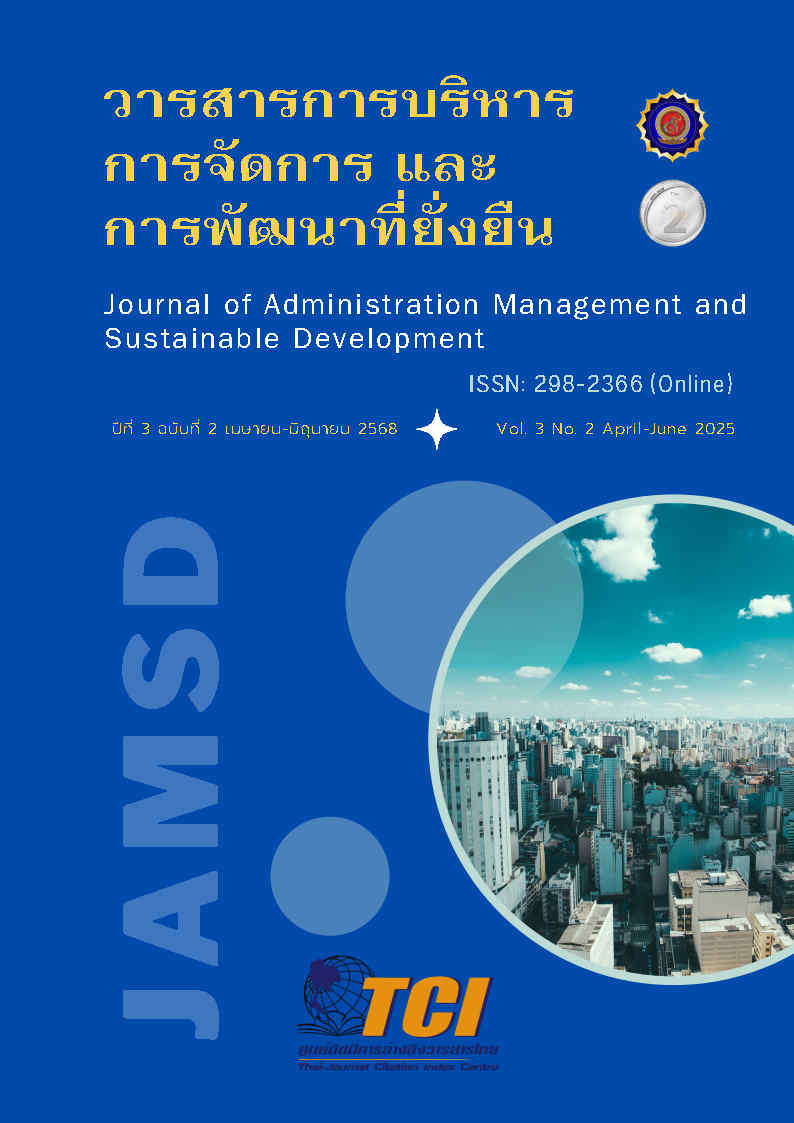Human capital management principles for success
Keywords:
human capital, management, efficiency, effectivenessAbstract
This article aims to present 1. the significance, background, and meaning of human capital management and 2. principles of human capital management for success in terms of both efficiency and effectiveness according to the organization's goals, from researching various related documents, which will consist of job analysis and manpower planning, employee recruitment and selection, employee development, competency management, talent management, leadership, employee motivation and retention, performance management, organizational environment analysis, international business management, and ethical principles in human capital management.
References
Adair, J. (2007). Leadership for innovation: How to organize team creativity and harvest ideas. London: Kogan Page.
Aguinis, H. (2013). Performance management (3rd ed.). Upper Saddle River, NJ: Pearson Education.
Armstrong, M. (2016). Armstrong’s Handbook of Strategic Human resource management (6th ed.). London, UK: Kogan page.
Bass, B. M. & Riggio, R. E. (2006). Transformational leadership (2nd ed.). Mahwah, NJ: Lawrence Erlbaum Associates.
Bass, B. M., & Avolio, B. J. (1994). Improving organizational effectiveness through transformational leadership. Thousand Oaks, CA: SAGE Publication.
Becker, G. S. (1964). Human capital: A theoretical and empirical analysis, with special reference to education. New York: National Bureau of Economic Research Distributed, Columbia University Press.
Blake, R., & Mouton, J. (1964). The managerial grid: The key to leadership excellence. Houston, TX: Gulf Publishing.
Blake, R., & Mouton, J. (1985). The managerial grid III: A new look at the classic that has boosted productivity and profits for thousands of corporations worldwide. Houston, TX: Gulf Publishing.
Boxall, P. F., & Purcell, J. (2016). Strategy and human resource management (4th ed.). Basingstoke, UK: Palgrave Macmillan.
Cardy, R. L. (2003). Performance management: Concepts, skills and exercises. Armonk, NY: M.E. Sharpe.
Coleman, J. S. (1988). Social capital in the creation of human capital. American Journal of Sociology, 94(1), S95–S120.
Cripe, E. J. (2012). Competency development guide: Resource guide for developing competencies (5th ed.). Fort Lauderdale, FL: Workitect.
Daniels, A. C., & Bailey, J. S. (2014). Performance management: Changing behavior that drives organizational effectiveness (5th ed.). Atlanta, GA: Aubrey Daniels International.
Davenport, T. O. (1999). Human capital: What is it and why people invest in it. San Francisco, CA: Jossey-Bass.
DeSimone, R. L., & Werner, J. M. (2012). Human resource development (6th ed.). Mason, OH: South-Western Cengage Learning.
Dess, G. G., & Picken, J. C. (1999). Beyond productivity: How leading companies achieve superior performance by leveraging their human capital. New York: American Management Association.
Dubois, D. D., & Rothwell, W. J. (2010). Competency-based human resource management. Boston, MA: Nicholas Brealey Publishing.
DuBrin, A. J. (2010). Principles of leadership (6th ed.). Mason, OH: South-Western Cengage Learning.
Fitz-enz, J. (2009). The ROI of human capital (2nd ed.). New York: Amacom Books.
Halpin, A. W., & Winer, B. J. (1957). A factorial study of the leader behavior descriptions. In R. M. Stogdill & A. E. Coons (eds.), Leader behavior: Its description and measurement. Columbus, OH: Bureau of Business Research, Ohio State University.
Hogan, R., Curphy, G. J., & Hogan, J. (1994). What we know about leadership: Effectiveness and personality. American Psychologist, 49(6), 493–504.
Kotter, J. P. (1988). The leadership factor. London, UK: Collier Macmillan.
Kaplan, R. S., & Norton, D. P. (1996). The balanced scorecard: Translating strategy into action. Boston, MA: Harvard Business School Press.
Katz, R. L. (1974). Skills of an effective administrator. Harvard Business Review, 52(5), 90-102.
Leahy, T. (2013). Management in ten words. London: Random House Business Books.
Lussier, R. N., & Achua, C. F. (2001). Leadership: Theory, Application, & Skill Development. Cincinnati, OH: South-Western College Publishing.
Lussier, R. N., & Achua, C. F. (2007). Effective leadership (3rd ed.). Mason, OH: Thomson/South-Western.
McClelland, D. C. (1973). Testing for competence rather than for “intelligence”. American Psychologist, 28(1), 1–14. https://doi.org/10.1037/h0034092.
McGuire, D. (2014). Human resource development (2nd ed.). London, UK: SAGE Publications.
Mullins, L. J. (2002). Management & organisational behavior (6th ed.). London: Prentice Hall.
Murphy, K. R., Cleveland, J. N., & Hanscom, M. E. (2018). Performance appraisal and management.
Los Angeles, CA: SAGE Publication.
Nadler, L., & Nadler, Z. (1992). Every manager’s guide to human resource development. San Francisco, CA: Jossey-Bass.
Palus, C. J., & Horth, D. M. (2002). The leader’s edge: Six creative competencies for navigating complex challenges. San Francisco, CA: Jossey-Bass.
Parker, J. P., & Begnaud, L. G. (2004). Developing creative leadership. Portsmouth, NH: Teacher Ideas Press.
Perkins, S. J., & Shortland, S. M. (2006). Strategic international human resource management. London, UK: Kogan Page.
Rao, T. V. (2004). Performance management and appraisal systems: HR tools for global competitiveness. New Delhi: Response Books.
Rothwell, W. J., & Graber, J. M. (2010). Competency-based training basics. Alexandria, VA: ASTD Press.
Schermerhorn, J. R. (2005). Management (8th ed.). Hoboken, NJ: John Wiley & Sons.
Schultz, T. W. (1961). Investment in human capital. The American Economic Review, 51(1), 1–17.
Swanson, R. A., & Holton, E. F. (2009). Foundations of human resource development (2nd ed.). San Francisco, CA: Berrett-Koehler.
Swart, J., Mann, C., Brown, S., & Price, A. (2005). Human resource development: Strategy and tactics. London: Taylor & Francis Group, Elsevier Butterworth Heinemann.
Truss, C., Mankin, D., & Kelliher, C. (2012). Strategic human resource management. Oxford, UK: Oxford University Press.
Walton, J., & Valentin, C. (2013). Human resource development practices and orthodoxies. Basingstoke, UK: Macmillan Education.
Weresa, M. A. (2014). Innovation, human capital and trade competitiveness. New York: Springer International Publishing.
Yorks, L. (2005). Strategic human resource development. Mason, OH: South-Western, Thomson.






